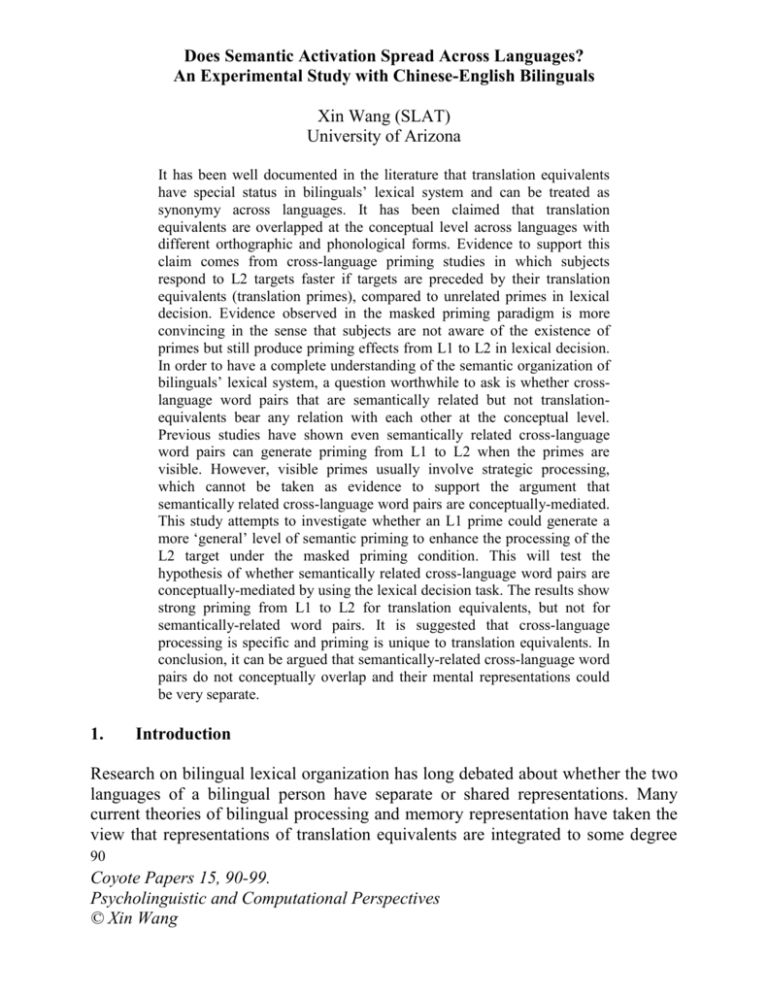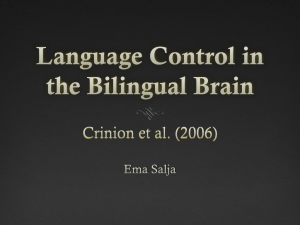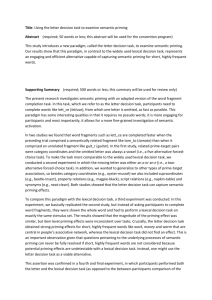semact - Coyote Papers
advertisement

Does Semantic Activation Spread Across Languages? An Experimental Study with Chinese-English Bilinguals Xin Wang (SLAT) University of Arizona It has been well documented in the literature that translation equivalents have special status in bilinguals’ lexical system and can be treated as synonymy across languages. It has been claimed that translation equivalents are overlapped at the conceptual level across languages with different orthographic and phonological forms. Evidence to support this claim comes from cross-language priming studies in which subjects respond to L2 targets faster if targets are preceded by their translation equivalents (translation primes), compared to unrelated primes in lexical decision. Evidence observed in the masked priming paradigm is more convincing in the sense that subjects are not aware of the existence of primes but still produce priming effects from L1 to L2 in lexical decision. In order to have a complete understanding of the semantic organization of bilinguals’ lexical system, a question worthwhile to ask is whether crosslanguage word pairs that are semantically related but not translationequivalents bear any relation with each other at the conceptual level. Previous studies have shown even semantically related cross-language word pairs can generate priming from L1 to L2 when the primes are visible. However, visible primes usually involve strategic processing, which cannot be taken as evidence to support the argument that semantically related cross-language word pairs are conceptually-mediated. This study attempts to investigate whether an L1 prime could generate a more ‘general’ level of semantic priming to enhance the processing of the L2 target under the masked priming condition. This will test the hypothesis of whether semantically related cross-language word pairs are conceptually-mediated by using the lexical decision task. The results show strong priming from L1 to L2 for translation equivalents, but not for semantically-related word pairs. It is suggested that cross-language processing is specific and priming is unique to translation equivalents. In conclusion, it can be argued that semantically-related cross-language word pairs do not conceptually overlap and their mental representations could be very separate. 1. Introduction Research on bilingual lexical organization has long debated about whether the two languages of a bilingual person have separate or shared representations. Many current theories of bilingual processing and memory representation have taken the view that representations of translation equivalents are integrated to some degree 90 Coyote Papers 15, 90-99. Psycholinguistic and Computational Perspectives © Xin Wang Xin Wang (e.g., Kroll & Stewart, 1994; Potter, So, Von Eckhart, & Feldman, 1984). For example, semantic priming experiments showed that the prior presentation of a word from one of the bilingual’s languages can facilitate the identification of its translation equivalent from the other language (de Groot & Nas, 1991). This suggests translation equivalents are linked with each other at the conceptual level of mental representation. The claim of shared conceptual representation of translation equivalents seems plausible because bilinguals usually learn their second language (L2) through first language (L1) by attaching the surface form of L2 to the established concept of L1. For example, Chinese-English bilinguals learn the English “apple” by mapping the English form to the established Chinese concept of ‘apple’ because they are translation equivalents across languages. Therefore, bilinguals’ two languages are directly linked at the conceptual level for translation equivalents. On the other hand, it has been of interest to researchers whether and how semantically related word pairs are linked across languages. In other words, are semantically-related word pairs (e.g. primary associates, like English ‘white’ and Chinese ‘black’) conceptually mediated across languages? An investigation of this question can not only shed light on the mental representation of bilingual lexicon, but also on the inter-lingual context effect in bilingual reading. 1.1 Previous Cross-Language Priming Studies To rigorously test the above hypothesis, psycholinguists have used an important paradigm: the primed lexical decision task (LDT), in which a trial presentation includes a prime word in between the fixation and the target word (Meyer & Schvaneveldt, 1971). The prime duration is usually referred as SOAs (stimulus onset asynchrony—the time between the onset of the prime and the onset of the target) that can be manipulated for particular experimental purposes. In monolingual experiments, a target preceded by a related word (CAT-DOG) is judged to be a real word faster than a target proceeded by an unrelated word (TABLE-DOG). This priming effect is semantic because CAT and DOG are more semantically related than TABLE and DOG. In a bilingual’s situation, the prime is in one language and the target in another. If priming is observed when the prime and target are in different languages, it is assumed that the word pair is integrated to some degree. Excluding cognates that share the similar form across languages, cross-language priming studies have used prime-targets that are translation equivalents along with semantically-related word pairs to investigate how semantic information was accessed from the surface level to the conceptual level across languages (Chen & Ng, 1989; Grainger & Beauvillain, 1988; Jin, 1990; Keatley, Spinks, & de Gelder, 1994; Schwanenflugel & Rey, 1986). The general findings revealed both translation and semantic facilitation effects in bilinguals at various 91 Xin Wang SOAs. Specifically, Chen & Ng’s study (1989) demonstrated reliable lexical decision facilitation from both translation and semantically-related primes with a 300ms (millisecond) SOA in Chinese-English bilinguals. They also reported advantage of translation over semantic facilitation, suggesting that lexical items in different languages were processed by means of an amodal conceptual system and the links between translation equivalents were stronger than those betweenlanguage links. Similarly, Korean-English bilinguals produced the same pattern of translation and associative facilitation when the SOA was 150ms (Jin, 1990). However, the cross-language priming effect was not consistently observed in some other studies. Grainger & Beauvillain (1988) tested English-French bilinguals in the same priming paradigm at different SOAs. The results showed a different pattern of effects for intra- and interlingual conditions at two different SOAs. At the SOA of 150ms, no facilitation effect was observed between associated words from different languages where facilitation was observed for associated words from the same language. At a long SOA (750ms), facilitation effects were found in both between- and within-language conditions, although the between-language effect was clearly weaker and unstable. If the associated words across languages are conceptually-mediated, priming effects should be observable between languages as well as within languages, assuming the existence of a common conceptual system for the two languages of the bilingual. In fact, the absence of inter-lingual facilitation effect would suggest that the underlying process is principally mediated by links between lexical units, these units being connected within languages in bilingual subjects and not between languages. It is possible that previous observations of interlingual semantic priming were due to the subjects’ use of predictive strategies in less temporally constrained conditions. More interestingly, in Keatley et al. (1994)’s study, both Chinese-English and Dutch-English bilinguals showed asymmetrical priming when the SOA was 250ms. That is, associative facilitation was only observed when the prime was the subjects’ L1, but not L2. However, translation facilitation was observed in both L1 and L2 primes. Regardless of the question of whether asymmetrical priming was observed on associates, the results would suggest a different mental representation of associates from translation equivalents across languages. 1.2 Masked Translation Priming A number of recent bilingual studies have used the masked priming paradigm to investigate how lexical entries in L1 and L2 are linked in bilinguals (Gollan, Forster & Frost, 1997; Grainger & French-Mestre, 1998; Jiang, 1999; Jiang & Forster, 2001, Davis, Kim & Sanchez-Casas, 2003, Finkbeiner, Forster, Nicol & Nakamura, 2004). The technique of masked priming adopts the procedure of 92 Xin Wang presenting a prime-target pair, where the prime is very briefly presented and immediately followed by the target. In addition, the prime is preceded by a forward mask and sometimes followed by a backward mask to prevent the subjects’ being aware of the existence of the prime. The benefit of using this technique is to enforce a more automatic word-recognition processing in which the prime goes under subjects’ explicit awareness and the target normally occurs within a short time. Therefore, unlike the traditional prime-target paradigm, masked priming avoids strategic influences due to the unconscious awareness of the prime. In a bilingual’s case, the prime-target pair is a pair of words across languages. Because subjects are not consciously aware of the prime, they only ‘see’ the target word during one trial presentation. Therefore, it is unlikely that they can predict the prime-target relationship and apply some strategies in responding to the target. Thus, the technique provides a more accurate tool to investigate how the bilingual lexical system works and is organized in memory. One line of research adopting the masked priming procedure has been looking across languages of different scripts. Forster and Jiang (2001) reason that strong translation priming effects across languages with distinctive scripts need to occur at the conceptual level because of their orthographic differences. This interpretation has been supported by various bilingual studies in lexical decision tasks (Gollan et al., 1997; Jiang, 1999; Finkbeiner et al., 2004). For instance, for Hebrew-English bilinguals, both cognates and non-cognates show strong priming effects, whereas for Spanish-English bilinguals, only cognates show any effect. Priming observed in cognates is considered to occur at the lexical level because the prime and target share the similar form (e.g. English ‘client’ and Spanish ‘cliente’). It is unlikely the non-cognate priming is due to the overlap of form because English ‘house’ and Spanish ‘casa’ are different in spelling. Therefore, noncognate priming is conceptual because the meaning of the prime needs to be accessed in order to benefit processing the target. 2. Experiment One However, the data provided by previous masked priming studies showed some limitations in the pattern of facilitation effects between words from different languages. These authors examined the presence of priming effects between translation equivalents and demonstrated that prior presentation of a masked word in L1 facilitated lexical decision to its translation equivalent, which is consistent with the results from the traditional cross-language priming studies. Again, masked translation priming studies provide converging evidence that supports the claim that the lexical representations of translation equivalents are conceptually mediated, even for bilinguals whose two languages use different scripts. Apart from 93 Xin Wang clarifying the linguistic representations of translation equivalents in a bilingual’s memory, the masked priming technique could be used as a more accurate method to address the question concerning how semantic information was processed and organized of associates across languages. On the other hand, this might provide a clue about the mixed results from the traditional cross-language priming studies with different SOAs, with respect to understanding whether semantically-related word pairs across languages are conceptually linked or not in the bilingual lexicon. Adopting the masked priming procedure, this study attempts to examine the priming effect from L1 to L2 on translation equivalents and semantically-related word pairs across languages of different scripts and address the question of whether an L1 prime could generate a more ‘general’ level of semantic priming so as to benefit the processing of the L2 target. In other words, does semantic activation spread across languages? The experiment reported here was designed to test the presence or absence of interlingual translation and associative facilitation under the masked priming condition in Chinese-English bilingual subjects whose two languages use different orthographic systems. 2.1 Method 2.1.1 Participants Twenty-seven Chinese-English bilingual undergraduates and graduate students were recruited from the University of Arizona for this experiment. All of them were native speakers of Chinese and had lived in the USA for at least 9 months by the time of testing. Participants had received a minimum of 8 years of formal English instruction in China. They scored above 550 in the standard TOEFL test before they came to the USA. All the subjects were paid to participate in the study. 2.1.2 Materials and Design In order to ensure translation equivalency for each Chinese-English prime-target word pair, two Chinese-English bilinguals were asked to translate a list of 200 words/items from English into Chinese; another two were consulted to translate the same words from Chinese to English. Forty-eight Chinese-English prime-targets who maintained translation consistency in both directions by all of the consultants were selected for this study. In addition, all of these translation equivalents were concrete nouns. Another 48 Chinese lexical items were selected so that they were primary associates of the previously developed 48 translation equivalents. The interlingual associate pairs were chosen so that the English target was semantically related to 94 Xin Wang the Chinese prime word (e.g. BLACK is semantically related to 白色 <white>). In order to ensure the semantic relation between languages, the semantically-related Chinese primes all share one morpheme in common with the Chinese translation equivalents of every English target. For example, the translation equivalents (黑 色 —BLACK) are compared to their semantically-related Chinese prime 白色 (white). Chinese 白色 is semantically related to 黑色 and share one morpheme 色, which means a type of color in Chinese. The shared morpheme ensures the translation prime and semantically related prime belong to the same semantic category. Forty-eight Chinese control primes, matched in frequency and length to the semantically-related and translation Chinese primes, were selected to combine with English targets. The Chinese stimuli were two or three-character words and ensured to match in frequency and length across the three prime conditions. Forty-eight English non-word targets, constructed by changing one letter at random in a word to form an orthographically legal and pronounceable letter string in English, were combined with 48 Chinese prime words. These Chinese primes were different from any Chinese primes combined with English word targets. Three counterbalanced lists were constructed so that each English target word was observed in three conditions: primed by translation equivalents, semantically-related Chinese words, or unrelated Chinese words. Therefore, the design included two within-subject factors: type of target (word or non-word), and prime-target relation (translation equivalent, semantically related, or semantically unrelated). The design was within subject, meaning each subject was presented with every English target only once. Each list was presented as four blocks of items of equal number. Each block included an equal number of words and non-words. Both blocks and items within each block were randomly presented. Ten Chinese-English word pairs were constructed as practice trials preceding the real test. 2.1.3 Procedure This experiment adopted the same L1 to L2 masked priming procedure as in Jiang’s studies (1999): each trial started with the visual stimulus of 500ms forward mask (贔贔贔贔贔贔), which was followed by a Chinese prime (translation, semantically-related, or control) for 50ms, and then the English target word in upper-case for 500ms. The forward mask component “ 贔 ” is a very lowfrequency Chinese character. All the tested subjects claimed they did not know this character. This sequence of presentation from L1 to L2 was able to prevent the subjects from being aware of the existence of the Chinese characters as all the subjects expressed not seeing the primes after the test. 95 Xin Wang Subjects read the instructions in English on the paper before the test. They were asked to respond “YES” if the presented letter-string was an English word and “NO” if it was a non-word. The experiment was conducted in the psycholinguistic lab using the DMDX package developed at the University of Arizona by J. C. Forster (Forster & Forster, 2003). The program calculates response times (RTs) to the nearest millisecond and error rates. 3. Results The mean reaction times and error rates are shown in Table 1. In analyzing the results of the experiment, data from trials on which an error occurred were not included and outliers were treated by setting them equal to the cutoffs established at two standard deviations above or below the mean for each subject. Two-way ANOVA only shows a significant effect of priming of 35ms for translation equivalents in both subject and item analysis [F1(1, 27)=9.83, p=0.005<0.05; F2(1, 48)=8.83, p=0.005<0.05], but not for semantically-related word pairs . In addition, the mean error rate was 11.5% and did not differ significantly between conditions. TABLE 1: Mean Reaction Times (in milliseconds) and Error Rates (in percentages) for all items Translation Semantic Proximity Unrelated equivalent 白色(white) --- BLACK 贡献(to contribute)--- BLACK 黑色----BLACK RT 735* 762 770 ER 11 9.6 13.8 4. Discussion The results of this experiment complete and confirm those of traditional crosslanguage priming studies examining interlingual associative priming at a short SOA, and suggest that the lexical representations of associated words from different languages are not directly linked in the bilingual lexicon. If such direct cross-language links did exist, one would expect to observe similar priming effects as in translation equivalents. Therefore, this implies that previous observations of interlingual semantic priming under the traditional cross-language priming paradigm were probably due to strategic processing rather than automatic lexical processing. It appears that translation equivalents and semantically-related word pairs across languages bear different mental representations in the bilingual lexicon. In 96 Xin Wang other words, conceptual nodes in semantic memory seem to be mediating representation involved in translation priming, but associative priming is not across languages. Therefore, semantic activation does not spread across languages. This conclusion supports the hypothesis that semantic priming is strictly intra-lexical and operates between associatively-linked lexical representations (Fodor, 1983; Forster, 1979). That is, BREAD can automatically facilitate identification of BUTTER because the two words are associated through experiences and not because they are related in the semantic memory network. It is possible that bilinguals’ lexical knowledge of L2 is organized in terms of the procedures by which L2 is acquired and such procedures may be language-dependent. Because bilinguals rarely encounter combinations of the type across languages (e.g. 白色BLACK), no such associative links will be formed in the bilingual lexicon. Thus the lexical representations of BLACK and WHITE may be directly connected in bilingual subjects’ English lexical system, just as 白色 (white) and 黑色 (black) may be connected in the Chinese lexical system. However, the lexical representations of 白色 and BLACK will not be directly connected at this level. Translation equivalents turn out to be in a different situation since bilinguals usually learn their L2 through L1 translation, thus L2 lexical representations are formed by the associative links across languages at the conceptual level in the bilingual’s experience. Evidently, translation priming effects observed in the masked paradigm were subtended by language-free conceptual representations. 5. Pedagogical Implication Proficient Chinese-English bilinguals demonstrated clear advantage in processing translation equivalents over semantically-related word pairs across languages. This suggests that L1 could be used as an effective and efficient tool to reinforce the mapping between L2 form and meaning during the learning process. From a different perspective, this study provides cognitive processing evidence against the pedagogical argument that L2 vocabulary learning should shift away from learning words with their translations but rely on L2 context. The complication of this issue depends on how L2 learners process L2 in relation to L1, because L1 could be facilitating or interfering. However, disregarding the translation approach in L2 learning is without empirical support. 97 Xin Wang References Beauvillain, J. G. C. (1988). Associative priming in bilinguals: Some limits of interlingual facilitation effects. Canadian Journal of Psychology, 42(3), 261-273. Davis, C., Kim, J., & Sanchez-Casas, R. (2003). Masked priming across languages: An insight into bilingual lexical processing. In S. Kinoshita, & S. J. Jupker (Eds.), Masked priming: The state of the art (1 ed.) (pp. 309-322). New York: Psychology Press. de Groot, A. M. B. (1983). The range of automatic spreading activation in word priming Journal of Verbal Learning & Verbal Behavior, 22, 417-436. De Groot, A. M. B. N., G. L. . (1991). Lexical representation of cognates and noncognates in compound bilinguals. Journal of Memory & Language, 30, 90-123. Finkbeiner, M., Forster, K., Nicol, J., & Nakamura, K. (2004). The role of polysemy in masked semantic and translation priming. Journal of Memory & Language, 51(1), 1-22. Fodor, J. A. (1983). The modularity of mind: an essay on faculty psychology. Forster, K. I. (1979). Levels of processing and the structure of the language processor. In W. E. C. E. Walker (Ed.), Sentence processing: Psycholinguistic studies presented to Merrill Garrett. Hillsdale, NJ: Erlbaum. Forster, K. I., & Forster, J. C. (2003). DMDX: A windows display program with millisecond accuracy. Behavior Research Methods, Instruments & Computers, 35(1), 116-124. Forster, K. I., & Jiang, N. (2001). The nature of the bilingual lexicon: Experiments with the masked priming paradigm. In J. L. Nicol (Ed.), One mind, two languages: Bilingual language processing (1 ed.) (pp. 72-83). Malden, MA: Blackwell. Gelder, C. W. K. J. A. S. B. d. (1994). Asymmetrical cross-language priming effects. Memory & Cognition, 22(1), 70-84. Gollan, T. H., Forster, K. I., & Frost, R. (1997). Translation priming with different scripts: Masked priming with cognates and non-cognates in Hebrew-English bilinguals. Journal of Experimental Psychology: Learning, Memory, and Cognition, 23(5), 1122-1139. Grainger, J., & French-Mestre, C. (1998). Masked priming by translation equivalents in proficient bilinguals. Language and Cognitive Processes, 13(6), 601-623. Jiang, N. (1999). Testing processing explanations for the asymmetry in masked cross-language priming. Bilingualism: Language and Cognition, 2(1), 59-75. Jiang, N., & Forster, K. I. (2001). Cross-language priming asymmetries in lexical decision and episodic recognition. Journal of Memory and Language, 44(1), 32-51. Jin, Y.-S. (1990). Effects of concreteness on cross-language priming in lexical decisions. Perceptual and Motor Skills, 70, 1139-1154. Keatly, C. W., Spinks, J. A., & De Gelder, B. (1994). Asymmetrical cross-language priming effects. Memory and Cognition, 22, 70-84. Kroll, J. F., & Steward, E. (1994). Category interference in translation and picture naming: evidence for asymmetric connections between bilingual memory representations. Journal of Memory and Language, 33, 149—74. Meyer, D. E. S., R. W. . (1971). Facilitation in recognizing pairs of words: Evidence of a dependence between retrieval operations. Journal of Experimental Psychology, 90, 227-234. Neely, J. H. (1977). Semantic priming and retrieval from lexical memory: the roles of inhibitionless spreading activation and limited-capacity attention. Journal of Experimental Psychology: General, 106, 226-254. Ng, H.-C. C. M.-L. (1989). Semantic facilitation and translation priming effects in ChineseEnglish bilinguals. Memory & Cognition, 17(4), 454-462. 98 Xin Wang Potter, M. C., So, K. F., Von Eckhart, B., & Feldman, L. B. (1984). Lexical and conceptual representation in beginning and proficient bilinguals. Journal of Verbal Learning and Verbal Behavior, 23, 23-38. Sanchez-Casas, R. M., Davis, C. W., & Garcia-Albea, J. E. (1992). Bilingual lexical processing: Exploring the cognate/non-cognate distinction. European Journal of Cognitive Psychology, 4, 293—310. Schwanenflugel, P. J. R., M. . (1986). Interlingual semantic facilitation: Evidence for a common representational system in the bilingual lexicon. Journal of Memory & Language, 25, 605618. Xin Wang Psychology Department University of Arizona Tucson, AZ 85721 Email: xwang@email.arizona.edu 99






